| Author | Message | ||
| edwardofhuncote
Senior Member Username: edwardofhuncote Post Number: 674 Registered: 6-2014 |
I don't have many relatives that play music, just a couple distant cousins and my Dad. Turns out, my Dad's 1st cousin played bass with a few notables back in the 1950's, George Hamilton IV, and John D. Loudermilk (cousin of the Louvin Bros.) to name a couple. Anyway, he quit playing in the late 1970's... wound the strings down on his old blonde Kay bass, and hung it up for a career in telecommunications. Ever since I was a kid first showing interest in playing, Dad always talked about his cousin's retired bass, and how he'd like to buy it, and well.. he finally got a chance. His cousin is currently downsizing, and moving into a retirement community, and called the other day asking if Dad was still interested in the old bass. So we made the trip down to Central North Carolina last Tuesday, and sure enough there it was, still zipped in the old canvas bag. Darn thing is near mint condition, just some very minor scratches to the finish here and there. The fingerboard is deeply grooved though, and will have to be planed. The worst of it - one critical repair is needed. Sometime over the last 40 years, the bass bar has come unglued from the top. Thank goodness the bass was completely de-tuned or the top would have collapsed long ago under tension. As it is, all I have to do is pull the top off and re-glue it. It's a big job, but I should be able to knock it out this weekend. I'm happy for Pops... I wound up buying out his half of an Englehardt bass we bought halfsies a couple years ago. He won't be needing that one anymore I guess. =) I'll post some more pictures along the way, but here's a teaser. 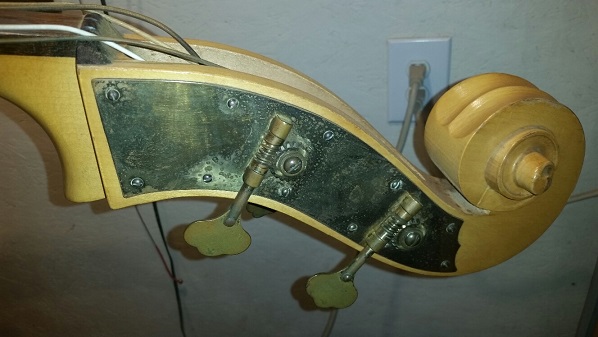 Oh, almost forgot this detail - under that natural blonde finish, the sides and back are some beautiful birdseye maple laminate... just like a certain Alembic bass under construction now. | ||
| richbass939
Senior Member Username: richbass939 Post Number: 1236 Registered: 11-2004 |
It reminds me of an Englehardt, blond, bass I owned in the 70s. A friend brokered its sale for me sometime in 1978. I really enjoyed that bass even though I didn't really know what I was doing, playing-wise. Rich | ||
| mtjam
Advanced Member Username: mtjam Post Number: 348 Registered: 11-2011 |
Glad to hear your dad was able to get this bass. I'm sure you will get it into shape so the instrument, and your dad, can resume making music! | ||
| ed_zeppelin
Intermediate Member Username: ed_zeppelin Post Number: 187 Registered: 2-2010 |
Garrison Keillor says that string basses are like having elderly parents. They're cranky, don't like the cold and they're difficult to get in and out of cars. I think a bass bar is an excellent idea. 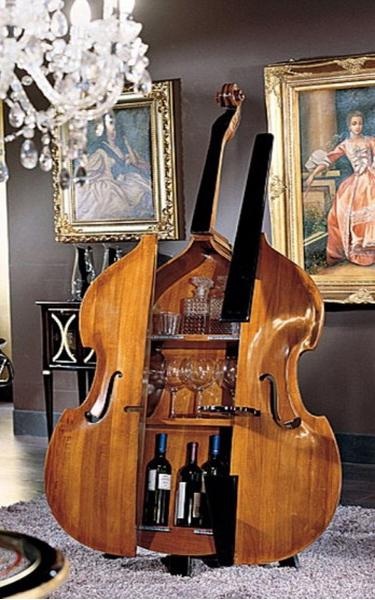 | ||
| edwardofhuncote
Senior Member Username: edwardofhuncote Post Number: 677 Registered: 6-2014 |
Well, we finally got some decent weather here in the mountains, so instead of working on Dad's new/old bass, I spent the entire Saturday & Sunday raking leaves. AND I'M DONE!!! The bass was *really* dry anyway, so it's had about a week to acclimate. I'll ease the top off tonight and re-glue that bass bar. Meanwhile, Dad took the old brass tuning machines home and polished them... sound familiar? =) 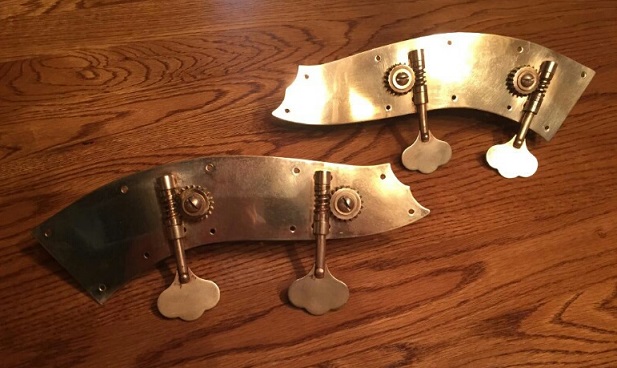 | ||
| sonicus
Senior Member Username: sonicus Post Number: 4591 Registered: 5-2009 |
This is a great project! I remember back in the early 1990's I did a restoration of a 3/4 size instrument made in the UK in 1947. It required reattaching the neck to the body and repairing a gash on the side. I did that project in my old apartment after my girl friend moved out which soon became the workspace for this labour of love type restoration. An old violin luthier became my advisor and restoration guru durring the process. I took about 8 months to do the work my self. I took some pictures in the process with my 35-MM film SLR . I need to scan those images and make digital images so that I can share them . Some of the methods used were a bit unorthodox but got the job done and were actually esthetically not offensive. The instrument played well and looked OK . I sold it in 2006. Wolf | ||
| dtothec
Member Username: dtothec Post Number: 63 Registered: 3-2015 |
That is a beautiful bass, i love the color. I started out on the upright bass and no one would believe this, but the one sedan that it would fit in with doors closed and windows up was a Volkswagen beetle. We had a 1978 and my bass teacher at the time showed me how to do it. You should have seen people's faces when they'd watch me do it, it would freak them out. I still have that bass it's a 1957 American Standard. If you look in the f hole of your Kay there should be a sticker with Kay and a number. You can use that number and go on line and find out what year it was made. | ||
| edwardofhuncote
Senior Member Username: edwardofhuncote Post Number: 679 Registered: 6-2014 |
Yessir, this one is an M1-B, with ink-stamped serial number 257XX this one dates to 1951. However, it doesn't have a paper label. The most probable reason being, it was made by Kay for another retailer, in this case Sears. Dad's cousin told us he bought it in 1953 with money from a paper route. I carried mine in a VW for several years and it worked okay, but it left very little room for dates. In retrospect, that might be one reason I had very few second dates. I knew a professor of music who had to carry his old Kay around in a Mercedes. To make it fit, he had the scroll sawed off, and fixed a lag screw so when he got to a gig, he would just screw the scroll back on. =) | ||
| ed_zeppelin
Intermediate Member Username: ed_zeppelin Post Number: 189 Registered: 2-2010 |
That reminds me of something I saw years ago, a great show called "Leo Kottke: Home and Away" on PBS. Here is the transcript: http://www.guitarmusic.org/kottke/gh&a1.html#end
| ||
| edwardofhuncote
Senior Member Username: edwardofhuncote Post Number: 683 Registered: 6-2014 |
Got the top off and re-glued the bass bar last night. The neck and tailblock, as well as the corner blocks glue joint came apart easily with the hot knife, but I have some minor veneer separations to fix before putting the top back on... that old dry plywood was just so brittle on the edges. Nothing a little titebond and clothespins won't fix. Here she is, glued and firmly clamped. (yes, I cleaned up the excess after this picture was made) 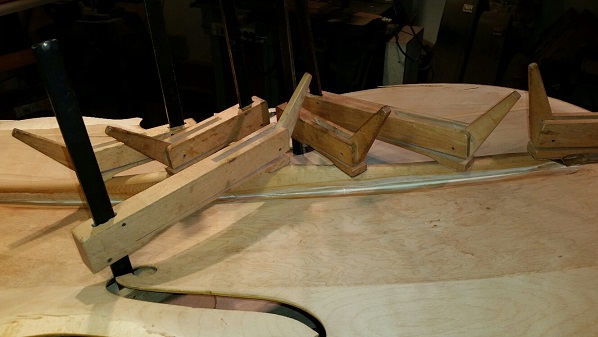 | ||
| sonicus
Senior Member Username: sonicus Post Number: 4595 Registered: 5-2009 |
Gregory , Are you using any" hide glue " ? I remember once making a purchase of some in the granular form for my own preparation . I also found some " Titebond" liquid hide glue . What " Titebond" version are you using ? Wolf | ||
| edwardofhuncote
Senior Member Username: edwardofhuncote Post Number: 684 Registered: 6-2014 |
I just use plain old Titebond wood glue on these laminated basses Wolf. Titebond does make a bottled hide glue, but it's usually out of date on the store shelves, and is notoriously unreliable for musical instrument repair once it gets old. For some of the finer basses and guitars that occasionally come my way, I have a small glue pot, and mix a batch of the granular hide glue one job at a time. The luthier I used to study under would often joke he needed to get me "off the bottle and on the pot." (there's probably a better joke in it, but frankly, sniffing hide glue just isn't worth it - ask anybody!) | ||
| sonicus
Senior Member Username: sonicus Post Number: 4596 Registered: 5-2009 |
When I first learned about making a " glue pot" with the granular stuff I suddenly became totally overwhelmed of the whole process of me attempting the repair as a complete novice. Somehow with the old luthiers coaching I made it through and was still a novice upon completion and still remain the such with just a bit more skill . As a result of my endeavor however I acquired even more respect and total awe for the craftsman such as yourself who can do this work for a living. Wolf | ||
| edwardofhuncote
Senior Member Username: edwardofhuncote Post Number: 686 Registered: 6-2014 |
Awww, shucks... Thanks Wolf, but I'm a hobbyist at best, and a cousin to Cletus D. Hack on other days. More later... wait'll you guys see the jig I use to clamp this top back onto Dad's bass! Oh, and I ordered a new set of strings for it... Innovation Golden Slaps are Dad's favorite... $169. (OWWW!) | ||
| richbass939
Senior Member Username: richbass939 Post Number: 1237 Registered: 11-2004 |
When I had my blond Englehardt 3/4 in the '70s I used to carry it in my Ford Pinto. I would fold the front passenger seatback forward, put the bass's bottom in the back seat behind the driver, and the head would fit perfectly where the passenger's knees would be. The bass and driver (nobody else, though) would fit very well. I very seldom took it any place so it wasn't too much of a pain. Rich (Message edited by richbass939 on November 22, 2015) | ||
| edwardofhuncote
Senior Member Username: edwardofhuncote Post Number: 711 Registered: 6-2014 |
Finished up the interior work, and re-glued the top on Dad's bass last night. (some of) These clamps are homemade, customized for exactly this job. Working on 6-foot tall violins presents some interesting challenges, one of them being - sometimes you have to improvise tools. I'm really happy with the way this one went back together. =) 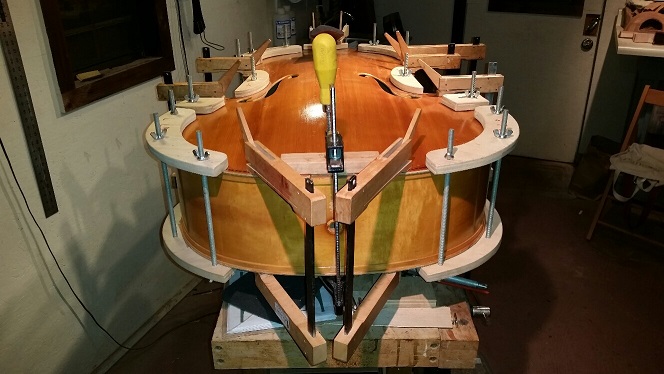 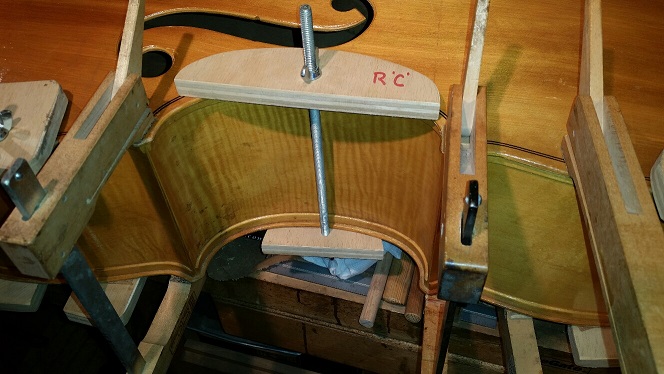 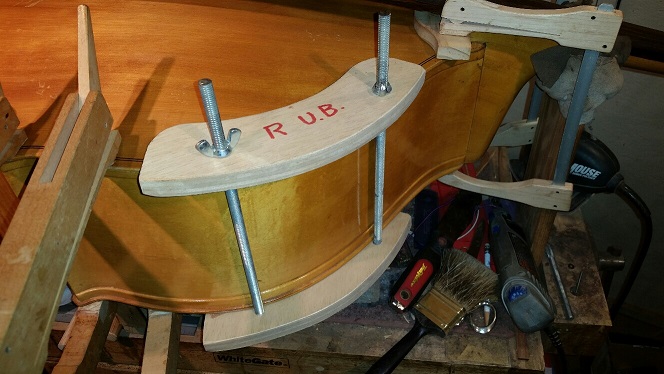 Next step, the fingerborad is deeply grooved from years of play. Not sure if I want to plane that much wear out of it, and replacing it (with period-correct brazilian rosewood) is insanely expensive. The next best option is to rout and fill with some remnants of old fingerboards, which I've done before with mixed aesthetic results. This makes for a solid but obvious fix... at least the repair is underneath a string, and therefore not as noticeable. Updates to follow. | ||
| growlypants
Intermediate Member Username: growlypants Post Number: 154 Registered: 3-2011 |
Wow! Looks like you've done this kind of work before, haven't you!!? (Excellent, and just kidding on your experience.) | ||
| sonicus
Senior Member Username: sonicus Post Number: 4638 Registered: 5-2009 |
Such a view of the clamping in this glue process is wonderful . I really appreciate being able to see the process of this restoration . I love those clamps ! Wolf | ||
| edwardofhuncote
Senior Member Username: edwardofhuncote Post Number: 721 Registered: 6-2014 |
Spent some more time in the shop the last couple nights. Decided to tackle the fingerboard issues first… Dad’s cousin played semi-professionally for several years, and though the fingerboard shows it, the rest of the bass is in almost mint condition. He must have taken very good care of it. Here’s what I started with. 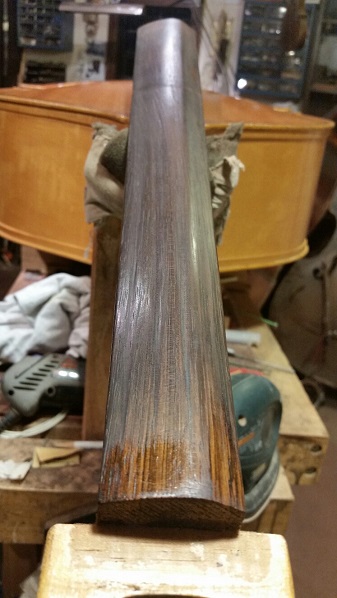 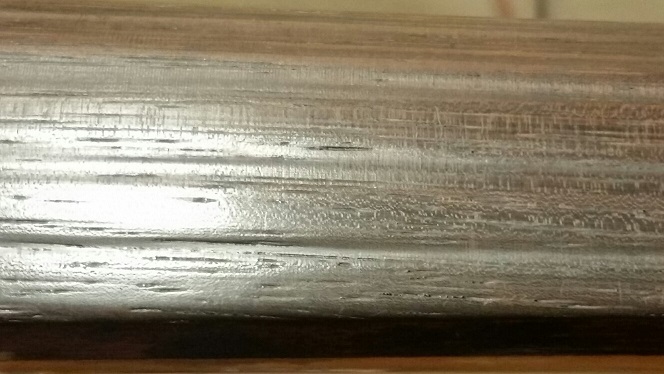 Rather than try to fill all those grooves in with some strips of rosewood, I decided instead to just plane them out, which also gave me a little steeper angle for the bridge. There really wasn’t much relief in the neck, like maybe a 1/16”… which is about what you need. Most of these old Kays that have been strung up for 50 years with high-tension steel strings are bowed about like a ski, but this one has been de-tuned for 30+ years, and had wound gut strings. (the wire windings by the way, are why this fingerboard got so chewed up) After a couple hours of block planning, and constantly checking for relief or high spots with chalk, then comes finish sanding. I like to wet sand ebony and rosewood with 600-grit, and follow with 0000 steel wool. The final polishing step, I use MinWax Finishing wax; it’s a petroleum based penetrating wax, rubbed in cross-grain, then buffed longways. Looks like this when you’re done. 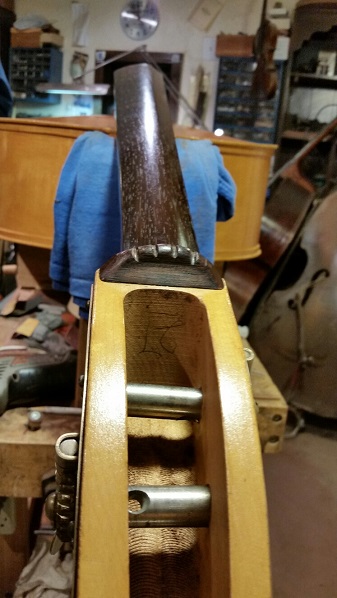 Did the same treatment to the tailpiece. That “Kay” badge is an aftermarket, supplied by the fine folks at Gollihur Music, upright bass specialists. Mark & Bob are great guys. Very much like our hosts here, Gollihur is a family business, and you quickly develop a personal relationship with them. So why did we need an aftermarket badge? Well, this bass is a legitimate 1951 Kay model M1-B, but it was made for Sears-Roebuck, so it bears no Kay ID markings other than a serial number. 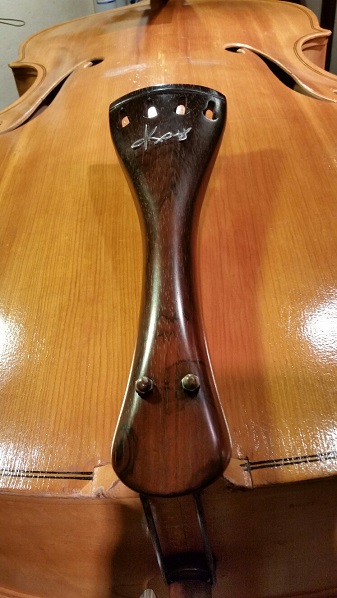 Here’s the biggest goof I’ve made on the whole project. As I said, the old plywood was so dry and brittle that removing that top was a nightmare, even with painstaking care. I saved all these little chips, and glued them back in place, and later sanded the joints smooth, then touched up with a highlighter marker. Followed by a little brush of clear lacquer, and the fix is seen, but not noticed. Unfortunately, I’ll *always* know it’s there. Anyway… this is where Cletus tips his hand. 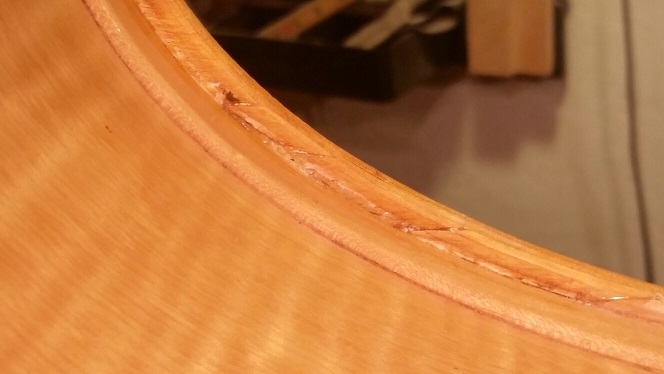 Here’s just a couple shots of the body showing what great condition it’s in… and what a mess my workbench is. Seriously, look at the birdseye maple in the back of this thing! It really pops with that blonde finish. Note how the spruce top veneer is darker… that’s not a trick of the camera or lighting, it really is darker.  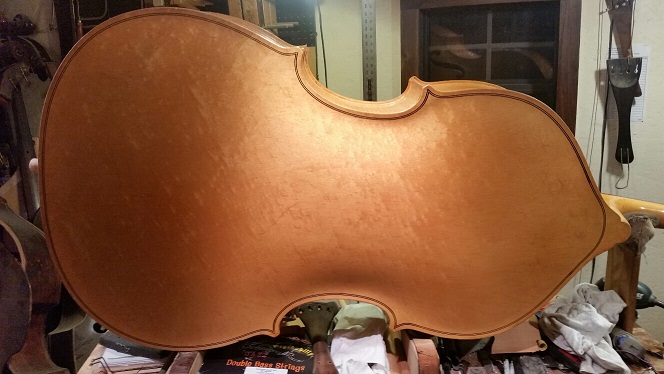 Provided all goes well with fitting a new bridge and soundpost, I’ll be ready to string this one back up Thursday night… good thing too – Dad has a gig on Friday! | ||
| ed_zeppelin
Advanced Member Username: ed_zeppelin Post Number: 204 Registered: 2-2010 |
Oh man, I can almost hear that baby (I can definitely smell it). Don't take this the wrong way, but I'd really love to slap it around. (Yeah, I said it.) I love the fingerboard wear in this 350+ year old Venetian bass. 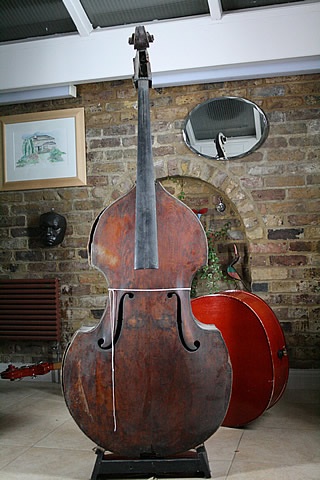 That's fingerboard wear from three and a half centuries of guys like us. Makes y'think, don't it? The Foghorn has me doing all kinds of "honeydew" chores today (got my whip and chair handy), so I keep popping in here to eyeball your achievement. I'm not saying that to elicit sympathy (though as a married man yourself, you may slather it on with a trowel if you feel so inclined. It won't go to waste, I assure you), but I feel the need to explain why this will probably be more disjointed than usual. Every time she sees me with this iPad, she makes a sound like a rhino getting ready to charge. Good thing I speak "wife" fluently, because I've been able to escape injury thus far due to my cat-like reflexes and my ability to look busy when I ain't doing squat. Yes, dear. Coming, hon. (The "Wife Whisperer" abides.) This ought to make your pappy happy: Rockstop endpin rest. Genius, no? I've got bruises from smacking myself in the forehead and going; "why didn't I think of that?" Plus, you can use it as a puck if some drunk gives you a hard time. Use the peghead of your P-bass to lay a slap-shot upside his skull ... I marvel at your skills. It takes balls the size of church bells to take the top off an upright bass (Cletus suggests a sawz-all, if explosives don't work), much less putting it back on so beautifully. I think it's gorgeous, and I mean that in all sincerity. (Six hours later! She's driving me like a rented mule today.) Here's a soft case for way cheap. 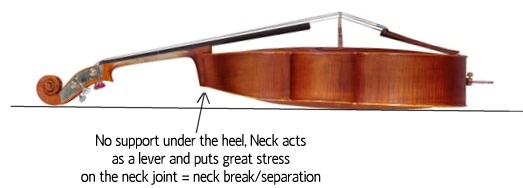 I velcro'd a wedgie-pillow in Brunhilde's soft case to avoid the big neck crack thing, 'cuz Cletus doesn't like messing with neck blocks or dovetails, y'know. He gets old spoon handles from Sally's, drills a couple holes in 'em and ...  Sounds *half-ass to me. Shadow 965 NFX upright pickup/preamp! Great sounding preamp, too. 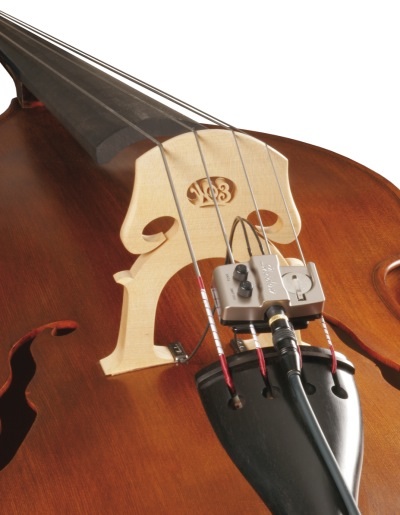 My (back's) favorite upright stand. The arms hug the waist, so you can play the bass while it's in the stand and you don't have to hold it up. Plus it's built like a tank. Everything's adjustable, so there's absolutely no wiggling (well, I do, but the bass don't). *i told Cletus that you didn't need an illustration, but he insisted. This is half-assed:  | ||
| edwardofhuncote
Senior Member Username: edwardofhuncote Post Number: 722 Registered: 6-2014 |
You're gifted Ed_Zep... I laughed all evening at your post. What's even funnier, or just wildly coincidental... the "spoon-handle" repair picture you posted, I am almost certain that is the neck heel of a New York made Epiphone, one of the finest, but notoriously fragile upright basses ever produced in the U.S. I have one in the shop right now (you can actually see it in the background) with a -you guessed it- a broken and BADLY repaired neck. Cletus struck again, this time with a carriage bolt. I got a Christmas party gig this evening, but I'm hoping to finish up Dad's bass tomorrow night. Stay tuned folks... | ||
| ed_zeppelin
Advanced Member Username: ed_zeppelin Post Number: 205 Registered: 2-2010 |
I was just looking at an Epi-uppy on eBay yesterday! The damn thing has been brutalized, probably the result of a "gang-slapping."  I went back and looked again, and there's the heel crack we all know and love, and evidence of at least one neck reset. (Break out the Elmer's and carriage-bolts!) At that price, he's not going to get that kind of money for it unless it's at gunpoint. And it's too bad because like you said, it's a venerable slapper and recording bass. As for your Pappy's Kay, I found this site with detailed info on Kay uprights. (Engelhardt, King, White and American Standard basses are also documented on that site, to some degree.) Kay basses are surprisingly rare, when you look at some of those production numbers. Note that blondes are the most valuable. As usual.  Kay was the first company to produce an internally-amplified upright bass, using a microphone mounted on the inside end of the peg. (You can hear the great James Jamerson use one in his German upright on "Heat Wave," "My Guy" and "Dancing In The Streets," as signified by a "U" in that list.) The company that made the peg/mic was named "AMplified PEG," later shortened to "Ampeg." Jamerson bought one of Ampeg's first amps, a B-15, which was recently rediscovered and authenticated on PBS' "History Detectives." "I'll take '#%¥£ nobody but bassists care about' for $200, Alex." With any luck, your pappy's Kay is a "Maestro" model, as played by The legendary Bill Black on all those great Sun recordings (in fact, it was Bill Black's combo, until a young singer named Elvis Presley joined.) Bill also played with The Maddox Brothers and Rose, the Burnette Brothers, Jerry Lee Lewis ("Great Balls of Fire!") the Everley Brothers and he was even a regular on Ozzy and Harriet until his tragic death from a brain tumor in 1965, at only 39 years of age. Bill was a real showman, too, climbing on top of his bass, twirling it and clowning around in general. His Kay Maestro bass is now owned by Paul McCartney. I truly wish I was there with you when you're doing "CSI" on that baby, checking details, measuring, comparing. It's one of my favorite things to do. If you ever have to fill or plane string wear out of a fingerboard again, you might want to try an old violin repair technique if you have to take the neck off: cut tiny strips (with a wedge-shaped profile) from the back of the fingerboard where it hangs out in space - and nobody will ever see without an inspection mirror - and inlay them into the grooves. Alternately, you can grind a little off the underside of the fingerboard and mix the resulting dust with epoxy and spackle it on the grooves. Dan Erlewine's "razor blade trick" comes in handy for stuff like that. This guy has a cool idea for a truss rod (kinda, since it only affects about half the neck). Great idea to keep in mind, though. Y'all's Summers back east play hob on wood, y'know. We haven't discussed amplification, which is a whole different beast with uprights. I've done a lot of experimenting with transducers, mics and preamps over the years. I'd love to compare notes. For recording, I've got a matched set of AKG C-1000 mics I like to XY at an area of the top corresponding to the end of the fingerboard, for a real "punchy" sound with minimal string noise. (The mics are actually aimed under the string and neck to isolate a square foot or so of real estate. I find that anywhere on the bottom bout tends to be too boomy.) For arco, I use an AKG 414 aimed just inside the bass f-hole from about six inches away (the tiniest adjustments allow more or less "air" from the f-hole.) through Sony MDR7506 headphones you can hear just astonishing differences with the slightest differences in angle. That's where the "God's own bass" tone lives, but it doesn't work as well with pizzicato, in my astoundingly humble opinion. For slapping, I really love the Fishman BP-100, because the ceramic-piezo transducers are attached by clips between the strings.  They're the only system I know of that allows you to compensate for different string's sensitivity and volume - (though it's a bitch and a half to set up initially). Just a hair (you know what kind  ) can spell the difference between people straining forward to hear or the whole front row being blown backwards out of their chairs, ears bleeding from the concussion blasts. ) can spell the difference between people straining forward to hear or the whole front row being blown backwards out of their chairs, ears bleeding from the concussion blasts. Once you've got the placement right, everything sorta moves "topside," if y'knowm sayin'. You're getting the exact tone of the strings themselves, rather than the sound of the bridge or bass body, as occurs with transducers mounted between the bridge and body, on or in the adjustment wheel or inserted into the bridge "scroll" doohickey. I've found that aside from the B-band (astronomically expensive) "ribbon" transducer element, there doesn't seem to be that much difference in the sound of bridge mounted piezos. (Remember Barcus Berry "hot dots?") the real difference is in the preamps. (He says. On Alembic's forum. To the collective "duh" from all the F2B Owners.) Believe it or not, that little Shadow pickup/preamp referenced in my earlier tome is just killer for straight-up "straight-to-amp drummer killer" kinda thing. I know! "That little thing?" Yup. David Gage "Realist": 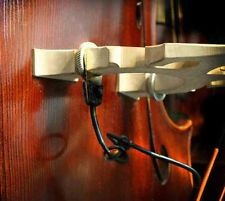 Fishman "Full Circle": 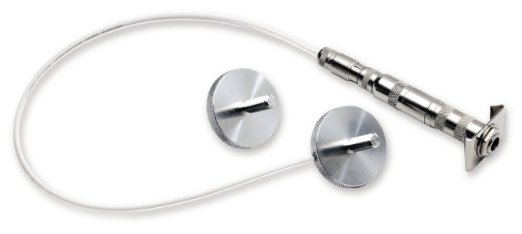 Anyway, I'd love to hear your input about this stuff. Besides, if your pappy is anything like mine, simple is better. You can't trust mine with a remote of any kind because he'll just punch buttons on it at random, expecting it to do what he thinks it should do by human/digital osmosis or something. ("Why is it always midnight on my VCR?" was written with him in mind.) | ||
| ed_zeppelin
Advanced Member Username: ed_zeppelin Post Number: 206 Registered: 2-2010 |
Duh. I forgot that you had given the model and serial number, and it is a Maestro, from 1951. Man, I've got the envy bad! That's the bass on "That's Alright" and "Hounddog!" It's that dreaded tenth commandment, the one about covetin' your neighbor's bass! I do fine with the others, but like most people here, the covetin' gets pretty hairy. It's not the first time I've envied someone over a blonde with a big bottom, though.  I can't even look at Jazzyvee's collection without getting that covetin' itch so bad I can feel it in my hip pocket. | ||
| edwardofhuncote
Senior Member Username: edwardofhuncote Post Number: 726 Registered: 6-2014 |
It's done and it turned out great! Dad just left here with his new/old bass. Both of us have gigs tomorrow night in opposite directions, but he's pretty tickled to be playing his first gig on this one. Pictures and post-game wrap-up tomorrow morning. | ||
| edwardofhuncote
Senior Member Username: edwardofhuncote Post Number: 727 Registered: 6-2014 |
Like I was saying, last night Dad came over to pick up his new/old bass, but before he did, I spent the afternoon doing the final setup and restringing. This usually takes me about 3-4 hours depending on what I run into. (or how many goofs I make) Generally it involves fitting (or re-fitting) the feet of the bridge to the top of the bass first. I start with 220-grit adhesive-backed sandpaper, stuck to the top scratchy side up. Carefully scrubbing the bridge in the spot where it will eventually be seated, the feet slowly start to match the contour of the top. Note the penciled hatching on the bridge feet… that’s how you know when you’re done. Having height adjusters, this bridge required a couple extra steps. Those little adjusting thumbwheels are nice, but they add a couple more angles to the equation. Dad loves his adjustable bridge, but I don’t care for going to the extra trouble of putting them on these laminated basses. I can totally see it if you have a 100-year old carved bass that moves a ¼” seasonally, but that’s just me. 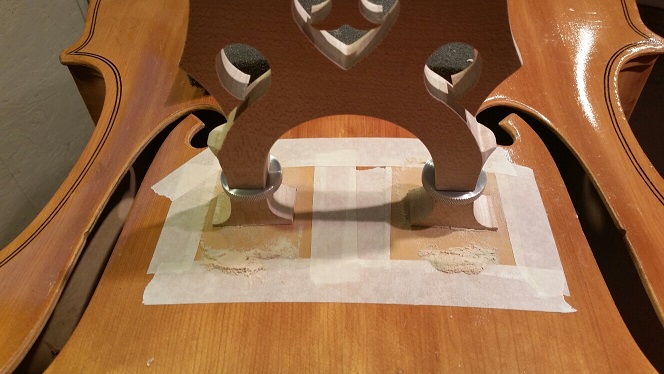   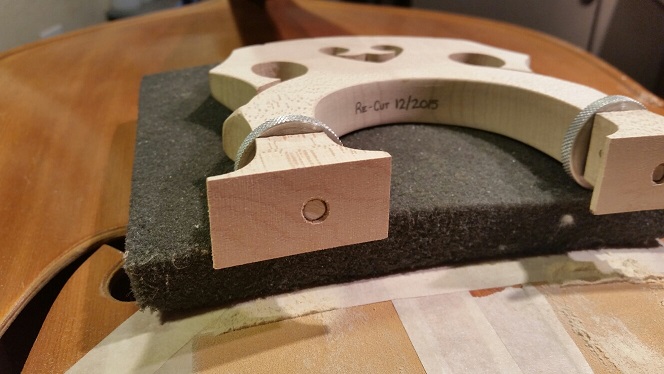 Next, marking and cutting the new bridge to match the crown of the fingerboard, This is so all four strings are the correct height off the fingerboard. I have a homemade tool for doing this… it ain’t anything ingenious - just a stick with a pencil in the end. Holding the bridge in place, just mark the projected flat action, (give yourself a little room to fudge) then cut the arc on the bandsaw. I didn’t stop to take a picture of that, but moving on... After the bridge is fit to the top, then it’s time for slotting the bridge for string spacing. I like to wait for this step, so as to compensate for any left/right yaw of the neck set. You can move the strings toward either side of the bridge, while still allowing it to stay centered in place. Like everything else, there’s a set standard for this spacing, but to be honest, I couldn’t recite it to you. I set the dividers for something between 1” and 1-1/8” for ¾ size basses, and locate the slots, then cut the slots with different gauges of round files. Typically, just deep enough so that only half the diameter of the string sits in the slot. To further prevent binding, and potentially breaking a VERY expensive string, use a good ol’ #2 pencil to lubricate the slots with graphite before final sanding. Like this:  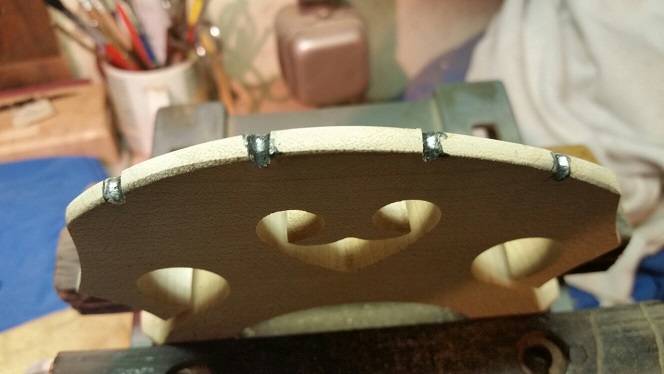 The fun part: Restringing. I absolutely hate to see a pegbox with a virtual bird’s nest of haphazardly wound strings. For pity’s sake, take 20 more minutes, trim the strings, singe and wax the ends with a candle, and wind them with some general care… it’s not like you’ll be doing it again anytime soon. I use a string winder, made for bass keys, and attached to a cordless screwdriver – zip-zip-zip-zip, done. Like this: 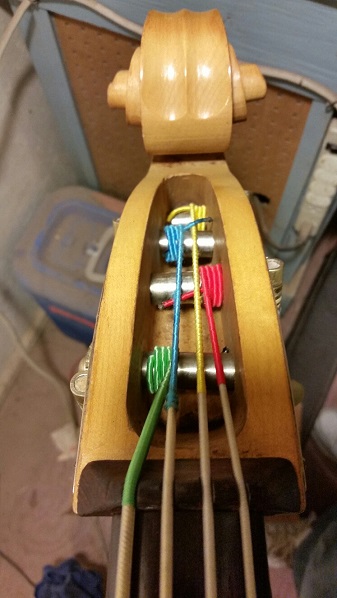 All this is the long way ‘round saying, when strung up, Dad’s new/old Kay was fantastic… one of the most balanced sounding Kays I recall, and LOUD as all giddy-up, and it plays like a dream, if I do say so myself! I got the action dead-on perfect, with room to go up or down. Often I’ll also have to cut and fit a new soundpost, but at Dad’s request I just reused the old one here. Last thing, I transferred his David Gage “Realist” pickup and docking port with volume knob (last years’ Christmas present) over to the Kay from the Engelhardt.   The Innovation “Golden Slaps” strings we put on should be stretched out in plenty of time for his gig tonight... here's what the whole bridge job looked like from the biz-niss end: 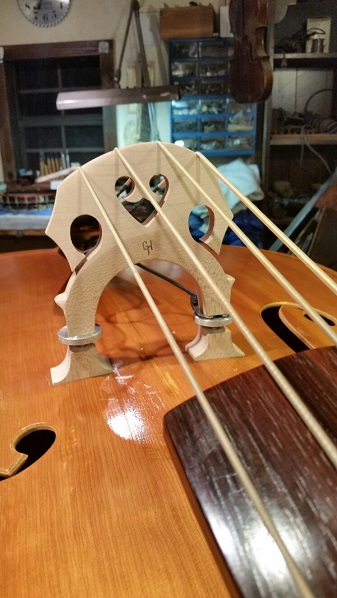 By the way – the Engelhardt we had bought together - is now mine… here it is on the workbench now, waiting it’s turn to be set up. 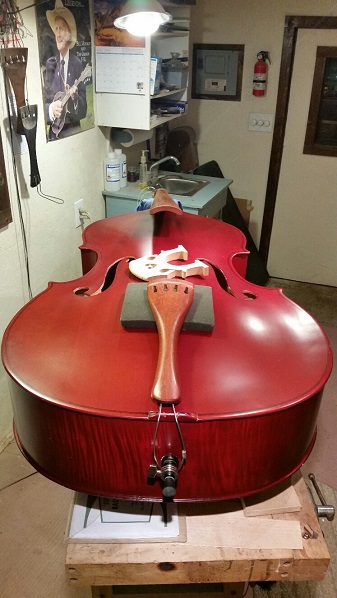 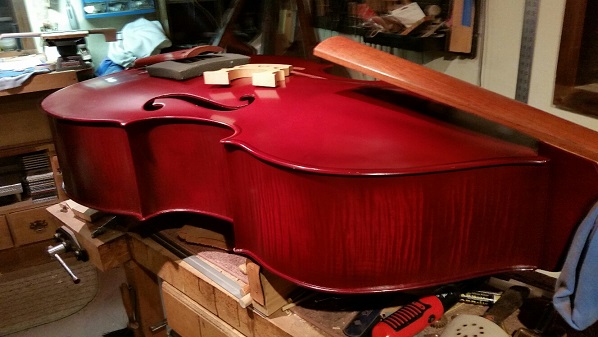 Can’t say enough good about Engelhardt-Link. Little bit of bass trivia, after they bought Kay in 1969, they kept on building basses with the advertising slogan: “made the Kay way.” Good bunch of people there, and it’s cool that you can call them up and get a real person on the phone who actually knows something about basses. | ||
| bigredbass
Senior Member Username: bigredbass Post Number: 2515 Registered: 9-2002 |
Greg, this is just fascinating, and thank you for the step x step pictures. I've always admired upright players, though it never interested me to learn to play one. So for a rank upright novice, I know fiddles have this wood bar from beneath the bridge to the back, what does this do? And, why do you wax the cut strings? Good on Ya to take care of Dad ! Joey | ||
| bigredbass
Senior Member Username: bigredbass Post Number: 2516 Registered: 9-2002 |
Greg, this is just fascinating, and thank you for the step x step pictures. I've always admired upright players, though it never interested me to learn to play one. So for a rank upright novice, I know fiddles have this wood bar from beneath the bridge to the back, what does this do? And, why do you wax the cut strings? Good on Ya to take care of Dad ! Joey | ||
| jon_jackson
Advanced Member Username: jon_jackson Post Number: 236 Registered: 12-2008 |
I agree with Joey. This is a great thread! Jon | ||
| flpete1uw
Senior Member Username: flpete1uw Post Number: 593 Registered: 11-2011 |
Greg, What a great honor to have such a skillset and shared interests with your Dad. Very nice work, you and your Dad are truly Blessed. Peace, Pete | ||
| susan
Moderator Username: susan Post Number: 126 Registered: 5-2002 |
Greg, Really enjoyed all your posts repairing your Dad's upright. What a beautiful job. Gotta love the custom made tooling...that definitely resonates with me :-) Susan | ||
| hankster
Senior Member Username: hankster Post Number: 424 Registered: 6-2004 |
Great thread. Made me happy to read it. If only my kids would do this with my bass! | ||
| edwardofhuncote
Senior Member Username: edwardofhuncote Post Number: 730 Registered: 6-2014 |
Joey, after cutting the strings to proper length, the silks tend to ravel. It’s a little hard to tell from the picture angle, but (the ends of) upright strings aren’t protected like on our bass guitars, that string end is still exposed even after winding over. Also, with these particular Innovation strings, the nylon inner windings kinda' do like a slinky-spring once cut. Just melting the ends a little stops that, and a quick dip in the hot parafin binds the silk. Truth be told, it ain’t necessary, but it’s just my neat-freak nature. =) The wood bar you've mentioned is called a soundpost, and you're correct - all members of the violin family have one. It's a spruce dowel, positioned vertically inside the body of the instrument, slightly below the treble side foot of the bridge, and held in place only by the downward pressure of the strings. It’s function is to provide support, but also to transfer the vibrations to the back. The fit is crucial… too loose and they tend to fall out of place, too tight and you kill the sound. There’s a special tool we use to install the soundpost, called a setter. It’s made so the soundpost can be moved around a little once inside, as sometimes you can alter the instrument’s tonal response by moving it. Here’s a couple pictures of the soundpost installed, the setter, and how they work together. You’d thing standing a stick up vertically inside a bass would be hard – and it is, virtually impossible without one of these.  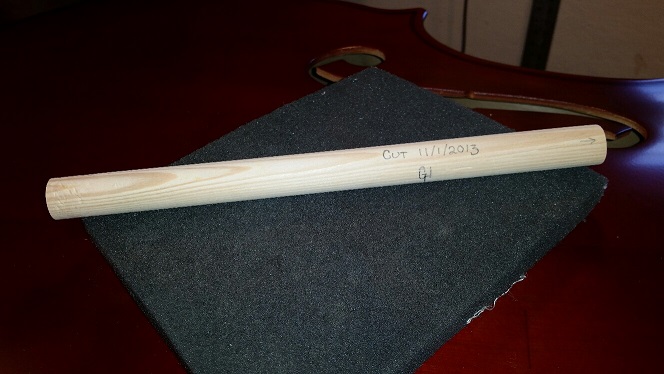  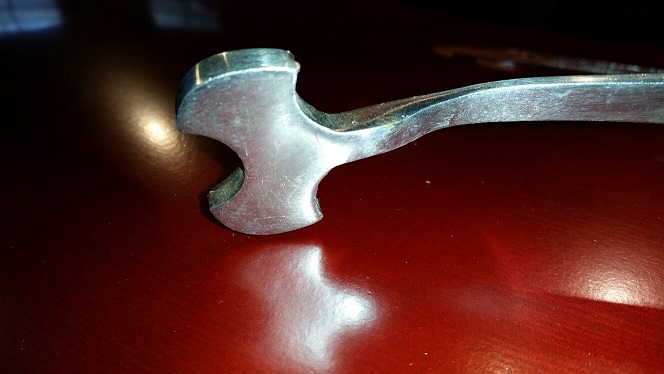 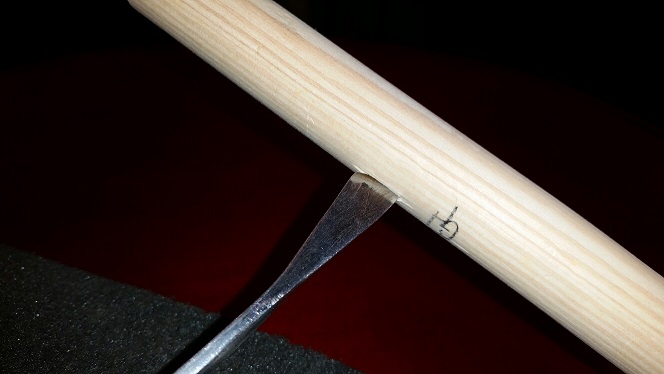 Also helps to have one of these laying around to retrieve the soundpost from inside. (because turning a six-foot violin upside-down and trying to shake it out… just isn’t a good plan) 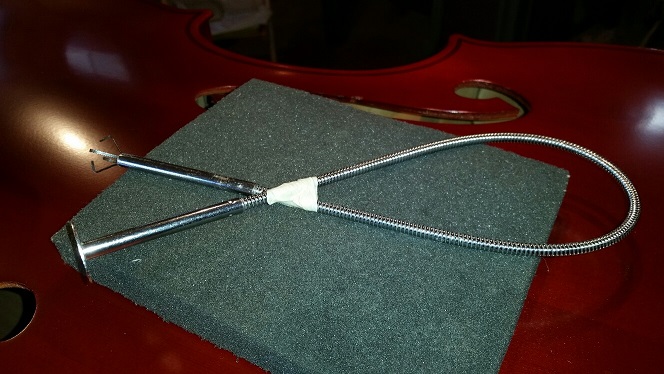 Oh, just for Ms. W., here’s that simple but effective homemade tool I use for projecting the arc of the fingerboard onto a new bridge:   Folks, I really appreciate the audience! And yeah… I kinda’ owe the Ol’ Man big time, not only for the musical influence but the shop work. I’m glad to work on something for him… especially since this bass has been in our family since new. Me and Pops have been building instruments together off and on since I was a kid. It’s fun having him over there, even if his messy style totally corrupts my groove! =) (Message edited by edwardofhuncote on December 21, 2015) | ||
| susan
Moderator Username: susan Post Number: 127 Registered: 5-2002 |
Greg, Thanks for the pics...seems very effective. The visual of someone shaking out a soundpost from a 6 foot violin gave me a chuckle. Always better to have the right tool for the job. Susan | ||
| bigredbass
Senior Member Username: bigredbass Post Number: 2517 Registered: 9-2002 |
It's funny in the way similar jobs require similar tools: Whe I worked at Gibson, it's a real pain installing electronics in thinline hollow-bodies (think 335's, etc.) and not much more fun with full Jazz boxes. So for 335's, they use a very similar looking tool to reach through the neck pickup hole and install the entire 4-pot, assembled, wiring harness with them sticking thru the 4 holes: Cinch the top nuts, solder the pickups and the jacks onto the leads, done, beginning with a setting tool that looks very similar. Joey | ||
| bigredbass
Senior Member Username: bigredbass Post Number: 2518 Registered: 9-2002 |
Greg, I wonder: Since the original idea for the great archtops is lifted directly from viol instruments (Flame maple box with spruce top, floating biredge, maple neck with ebony fingerboard), I wonder why (obviously, a guitar is held against you than 'floated' away from the body by a chin/shoulder rest as are violins) soundposts never showed up in guitars . . . . do they show up in their fretted first cousins, mandolin-family instruments? Joey | ||
| edwardofhuncote
Senior Member Username: edwardofhuncote Post Number: 731 Registered: 6-2014 |
Ha - I always wondered how in the world they got all that stuff inside an already assembled guitar! Re: archtop guitars/mandolins and soundposts, I've often wondered about that too Joey... maybe with an archtop instrument's back resting against you when played there is a dampening effect, that negates the transfer. Most likely it's more to do with the extra amount of downward force exerted on the top of guitars and mandolins with steel strings. (violins and larger members typically have rope core strings in varying tensions) I do know from a structural standpoint, with (most) carved top mandolins and guitars, the construction has two "tone bars" running lengthwise to brace the top, and that they are oriented so that they pass underneath the feet of the floating bridges... presumably to spread the vibrations out over the full soundboard. Violins conversely, have a single tone bar (usually called a bass bar) under the bass side of the instrument, and a soundpost supporting the treble side. If I had to guess, I'd reckon a violin with two tone bars instead of a soundpost would sound thin, just by virtue of the extra mass concentrated right where the top needs to be most resonant. Hmmm... just a guess, may need revision. | ||
| sonicus
Senior Member Username: sonicus Post Number: 4657 Registered: 5-2009 |
I have a vision now ! ________ It would be interesting for someone at Alembic to design a High Breed Acoustic Bass Guitar using a sound post as in the Double Bass with a Large Jumbo Body like the Guild B-50 was ( perhaps a bit bigger) . This new design could be like a 1/4 or less size Bass Violin design that you can play on your knee like a Guitar. If it had an Alembic Logo on it with the lovely Crown Head Stock design this instrument just might be irresistible !  If it had a small Bass Violin appearance that would be sweet . If it had an Alembic Pickup on it even better ( I see a single Fatboy with Volume /Filter . ) If it had a small Bass Violin appearance that would be sweet . If it had an Alembic Pickup on it even better ( I see a single Fatboy with Volume /Filter . ) Wolf | ||
| ed_zeppelin
Advanced Member Username: ed_zeppelin Post Number: 209 Registered: 2-2010 |
I always encourage electric bassists to take up the upright, just because it's so much fun. http://youtu.be/2SriEOjsDCo See what I mean? "Bass Guitar To Upright Bass: The Top Ten Mistakes Migrating Players Make." Greg, I couldn't be more impressed by your monumental achievement. I mean that right down to my core. Consider this a standing ovation (yeah, I'm sitting down, but you know what I mean). I know how insanely difficult it is to seat an adjustable bass bridge, correctly as only an inept buffoon who has learned a very valuable (as in; "expensive") lesson from hubris and over exuberance can attest. Brunhilde came with a warped fixed bridge, and I was all hot to get a David Gage Realist pickup so I picked up an adjustable bridge for her. Special order from Germany, too. Woo hoo! It's interesting that you used the word "yaw" because that's the perfect word to describe one of the three most important "vectors" to contend with when you're trying to sand the bridge's feet to conform to two separate compound angles, so that the bridge stands at a perfect right angle to a surprisingly flexible top (or "table") that slopes in approximately umpteen directions at once. It was the adjustable feet that doomed my first attempt. I smeared a dab of lipstick on the bottoms of the feet and taped sandpaper face-up on the top, measuring and measuring again and finally, C-clamping a long - straight - length of 1x1 molding to the end of the fingerboard for reference. (Like your homemade pencil gizmo.) That's where those adjustable feet threw me off. I got the worst thumb-cramps I've ever had from gripping those feet between my thumbs and index fingers, like I was trying to crack walnuts, and slowly dragging them back and forth, back and forth, back and forth ... Meanwhile, every time I paused and looked at the bottoms, a different part of the base was getting sanded off than I was expecting. Every time. I couldn't for the life of me figure out what was going on. I'd get closer and closer, then it would go wonky on me. Finally I realized that I should have placed the sound post first, because every time I gripped the crap out of those adjustable feet and bore down with extra determination, the table flexed. The more I tried to "work on" a certain area, the farther off it went. When I wrestled the sound post into place, it was too far gone and I think I may have sustained permanent damage from kicking myself in the ass. That's also when I found out that you can't buy the little feet separately, and of course I was too dumb to make my own. I took her to John Stewart in Massachusetts with my tail tucked between my legs (makes it difficult to walk, especially if you're prone to tail-wagging, like me) and vowed to never mess with classical instruments again. Good thing I did, too, because he told me that even though she's a hundred years old (still has her curves, though) nobody had ever set her up properly. The nut was too high, the soundpost had been turned around to some degree by some nimrod (raises hand) who was unaware that the end was "seated" to exactly conform with one particular angle, so that only about 10% or so was contacting the back ... My god, what a difference. There's an unbelievable amount of skill and knowledge involved in that stuff. And I had been playing upright since I had to stand on tiptoe to reach an "F" but had no idea that there was so much involved. I always say that because I started playing upright in school orchestras, by the time I figured out that I was too dumb to play it, I was already pretty good at it. Sonicus, the soundpost is really there for playing the bass with a bow ("arco"). There is no electric bass equivalent, because the bow literally excites the whole instrument (your left hand can go numb from the vibrations). It's the coolest feeling ever, and like the video of slapping I posted at the beginning of this seemingly never-ending rant demonstrates, it's surprisingly easy to do. Besides, the string bass is the most versatile orchestral instrument, by far. It's used in more types of music than any other instrument. It's changed very little in over three hundred years, and so it's our legacy as cool guys (that 350 year old bass I posted pictures of was hauled around Venice in gondolas, by guys exactly like us). My only other advice is to get lessons, because we hold our left hand differently so it's a lot less stressful on your fingers (especially the way we "balance" on our left thumb). Get it set up by a pro and arguably it'll be as easy to play as your Alembic, with slinkier strings. And once you get past the part of using a bow where it sounds like a walrus being tortured, you'll discover this incredibly powerful resonance and "singing" qualities that'll rock your world. Words can't describe it (that's never stopped me from shoveling as many as I can, though). | ||
| edwardofhuncote
Senior Member Username: edwardofhuncote Post Number: 732 Registered: 6-2014 |
Thanks Forest, but don't give too much credit. I'm just a C- student from the Skool of Life's Hard Knocks. As we say 'round here, "sometimes even a blind squirrel finds an acorn. =) But I do agree those adjustable bridges are the scourge of the world to cut properly. Seriously, I did have some good teachers along the way... the first being my Pops, but secondly and more directly, a topnotch luthier/repairman/genius jig-maker named Ward Elliott. Don't bother looking for Ward on the internet - he don't do the online thing. This 10 year-old thread on Mandolin Cafe is about all you'll ever find. His humble post is the last one. http://www.mandolincafe.com/forum/showthread.php?17322-Ward-Elliot-Mandolins After apprenticing under a violin-maker in the Pacific Northwest, he came home to Virginia and began doing his own repairwork. Later, he gained some notice by building the first sets of Stelling mandolins. A little later yet, he began building his own. These days, he mostly does repair and setup... the absolute BEST fretwork you've ever seen. Human PLEK machine. Guy can fix anything. | ||
| sonicus
Senior Member Username: sonicus Post Number: 4658 Registered: 5-2009 |
Forest , Mitchell Holman the original Bassist for " It's a Beautiful Day" built an interesting Electric Bass that he played Arco. I met him a few years ago when I drove up to his place to purchase an AMPEX and a STUDER tape machine from him .He told a little me a little about the bass in a discussion that we had .  That is a great article ! I sold my upright in 2005 . I was still using the French Bow Arco technique. Recently I thought that I might pick up another upright and use a German Bow Arco technique instead. Wolf | ||
| sonicus
Senior Member Username: sonicus Post Number: 4659 Registered: 5-2009 |
Gregory please excuse my last post . I have no intension to highjack. Just a response to the flow of the thread, Wolf | ||
| edwardofhuncote
Senior Member Username: edwardofhuncote Post Number: 733 Registered: 6-2014 |
All good Sonicus! The thread is pretty much done... I was just enjoying seeing where else it might go. =) | ||
| sonicus
Senior Member Username: sonicus Post Number: 4660 Registered: 5-2009 |
Gregory , Dear Sir , I have very much appreciated all that you have shared with us here in our little corner of the WEB , (The best spot ) I hope that you and your family will have a wonderful holiday season , Your Dad hopefully will have an exemplary memorable experience with his bass restored at the hands of his very own Son ! ( Surely a Fathers delight ) Coolness to the 10th power my friend ! Wolf (Message edited by sonicus on December 21, 2015) | ||
| ed_zeppelin
Advanced Member Username: ed_zeppelin Post Number: 210 Registered: 2-2010 |
Drool. I'm an analog guy in a digital world. I remember when people genuflected when saying those names. I'd pore over recording mags and dream of the day I could get an SSL Board and a 2" tape machine. Ha ha, the closest I got was the Drawmer gate that's still in my old road rack. I kept throwing money at PA stuff, just so I could gig and not be at the mercy of some jerk singer who had a PA, and next thing I knew everybody went ProTools and Cubase and are recording (c)rap music in their parent's basement, and the music industry did something very messy in their sleeping area. Sigh.
Congratulations on being the first to answer (in a rather oblique way) my riddle about Alembic being founded on rust.  | ||
| sonicus
Senior Member Username: sonicus Post Number: 4662 Registered: 5-2009 |
Gregory , I hope to find a nice 1/4 upright soon for my Frankenstein like experiments as a lap Bass ! FOREST , Iron oxide rules in it's various on existences as found on Acetate , Mylar, and Polyester tape base and in my vocational world as an analog to digital transfer audio engineer it is very important to know what I can bake in my lab oven or dehydrator and what NOT . ONLY bake mylar like AMPEX 456 and its kin types . Why do we bake a tape for you ? Because the binding chemistry has broken down on the Mylar stuff from certain makers and certain years . NEXT , know your flux density , for your alignment adjustment on the transfer machine. Many times it will be 185nWb/per meter on the early stuff . I did a Transfer a a few years ago recorded on 3M 111 dated 1959 ! Acetate based 1/4 " full track speed 15ips from an AFL-CIO source client that was amazing in the final product, The next day I did one recorded on AMPEX 456 from the 1980"S that was less then I would have liked it to be . The Mylar stuff is often where the most work must be done in the restoration process . More time spent with this material for an acceptable result. I like this link ; http://www.sengpielaudio.com/calculator-magneticflux.htm Wolf Bostedt AKA Sonicus Here @ The Alembic Club & Sonicus Alembicus on Soundcloud | ||
| davehouck
Moderator Username: davehouck Post Number: 12011 Registered: 5-2002 |
Greg; nice work! And thanks for sharing it with us. I also enjoyed reading the thread about Ward Elliott. | ||
| bigredbass
Senior Member Username: bigredbass Post Number: 2519 Registered: 9-2002 |
Arco with frets !?! Can NOT wait to see the look on the guy's face when you take this in for a re-fret and he opens the case . . . . http://thinkns.com/instruments/omnibass.php Joey | ||
| ed_zeppelin
Advanced Member Username: ed_zeppelin Post Number: 211 Registered: 2-2010 |
I wanted to point something out to Joey - even though it shines a spotlight on my own idiocy, as I explained - that shows the tremendous skill involved in even the most minor details with violin family instruments, and a lesson from that "Skool of life's hard knocks" Greg was talking about. He said; "the fit is crucial" and that the soundpost goes in between the top and the back (both curved surfaces) and even then, not in the middle. It has to go off to one side, under the foot on the bass side of the bridge. So the ends of the post have to be angled perfectly to make full contact, and placed precisely, or it has a profound effect on tone because it's transferring the vibrations from the top to the back. Look at the angles of the cuts on the ends of the soundpost. How does someone gauge that, through an f-hole? That's where experience, knowledge and mentors come in (none of which I have  ). ). 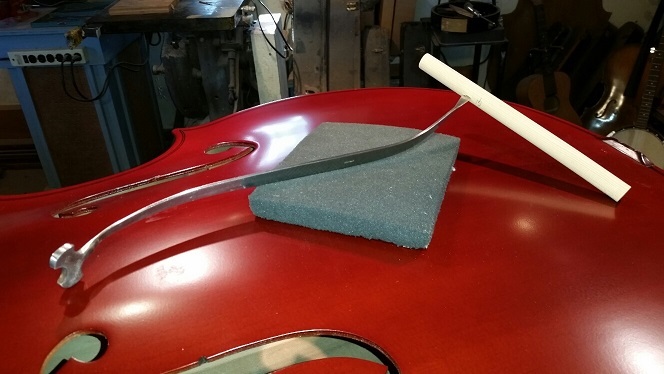 | ||
| sonicus
Senior Member Username: sonicus Post Number: 4665 Registered: 5-2009 |
Joey , that OMNI Bass link is interesting ! Thanks . Wolf | ||
| edwardofhuncote
Senior Member Username: edwardofhuncote Post Number: 750 Registered: 6-2014 |
Just to finish the story... Dad went back down to the Piedmont region of North Carolina today and took the bass back to visit it's original owner, his cousin Buddy Yearwood. Cousin Buddy seems to approve of the restoration... Dad sent me these pictures a minute ago. 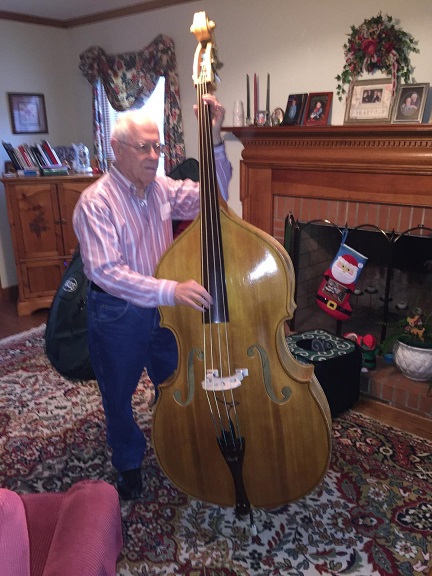 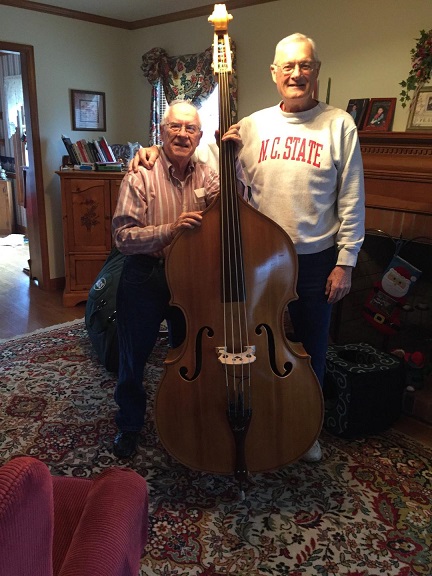 | ||
| growlypants
Intermediate Member Username: growlypants Post Number: 155 Registered: 3-2011 |
Wow. How cool is THAT!! | ||
| elwoodblue
Senior Member Username: elwoodblue Post Number: 1786 Registered: 6-2002 |
Very nice!! The first pic highlights the bookmatching. looking good  | ||
| sonicus
Senior Member Username: sonicus Post Number: 4686 Registered: 5-2009 |
This is just about as good as it gets . This has been such a beautiful process ! Simply wonderful . Wolf | ||
| bigredbass
Senior Member Username: bigredbass Post Number: 2524 Registered: 9-2002 |
Your Pops just looks so natural, so right at home with his bass in that first picture, what a hoot, and thanks for including us in this re-build. I mean this in a good way, but geez, it's got me all ate up with the Warm & Fuzzies !! My dad passed years ago, you're so fortunate to have him around where you can still do things like this for him. Joey | ||
| edwardofhuncote
Senior Member Username: edwardofhuncote Post Number: 751 Registered: 6-2014 |
Actually, (shoulda' said so in the post) the first picture is Cousin Buddy... my Dad is the tall one with the N.C. State sweater. =) But yeah, Dad said he zipped that old Kay out of the case, picked it up and played it like he'd never quit, even though he hadn't touched it in nearly 40 years. Notice how he (Buddy) addresses the bass - from slightly behind it, and with both wrists straight... that's the way. I'm trying to teach Pops at least how not to hurt himself with it... playing an upright is a very physical job. It's easy to adopt bad habits and in so doing, hurt yourself. For example, like by *not* doing what his cousin is in the picture. Just grabbing the neck like a ball bat, and flailing away at the strings will only get you a case of tendonitis and blisters. | ||
| tncaveman
Advanced Member Username: tncaveman Post Number: 309 Registered: 2-2011 |
Awesome thread. Thanks for sharing. Stephen |